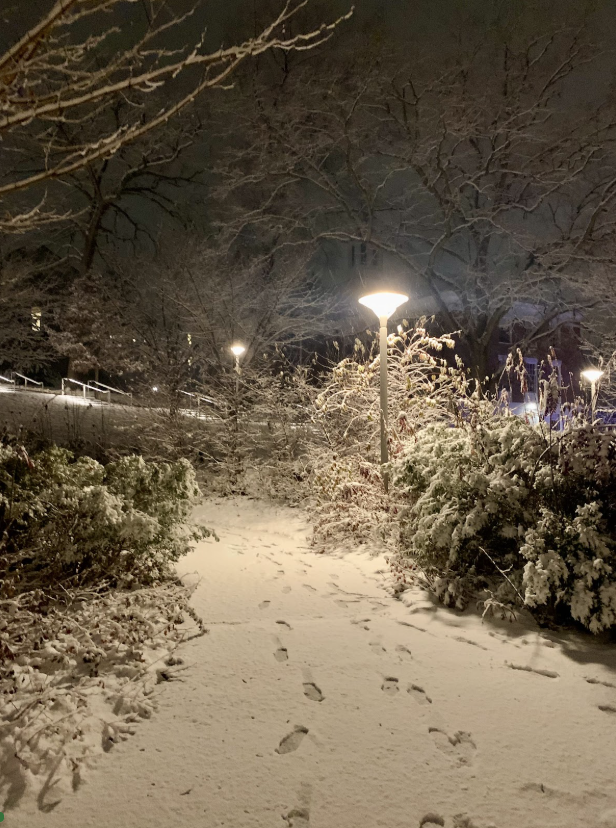Frost vs. The Science Center: Which Study Space Do You Prefer?
Why is it, amid global crises like climate change, the pandemic, rising poverty and social inequality, that Amherst students feel the need to debate which of their fancy study spaces they prefer? But while the question “Science Center or Frost?” may seem trivial, I feel that, because we are unable to leave campus, the spaces that are available to the students currently living in the Amherst bubble are more important to us than in ordinary years.
While there are a number of places students can study, from the Beneski Museum of Natural History to the Mead Art Museum, or even just outside on a nice day, only two such spaces truly dominate the Amherst study scene: Frost Library and the Science Center. Especially during the pandemic, in the Amherst bubble, these two spaces aren’t just for studying but also for socializing, eating meals, engaging in Zoom classes and more.
Frost Library, or just “Frost,” sits on the First-Year Quad. Named after on-and-off Amherst professor and American poet Robert Frost, it was constructed between 1963 and 1965. President John F. Kennedy actually presided over the dedication and groundbreaking ceremony in one of his final public appearances.
The Science Center, of course, is a much more modern creation. Completed in 2018, after enrollment in STEM classes at Amherst had been steadily increasing, the multi-million dollar structure replaced the old Merrill Science Center, a winding labyrinth of dark, underground corridors. The current senior class are the only students still on campus to have experienced the old science center.
When choosing where to study, students weigh several competing factors. First is the ability to work with others. Both spaces have been restructured for social distancing: Masks are required, chairs are placed far apart from each other and the number of students per table is limited.
“I kind of like the peer pressure of being around other people when I’m doing work in the Science Center in the main room,” said Claire Taylor ’23. “I feel like if I’m seeing other people doing work, I need to be productive. Sometimes that mindset helps me get things done.”
Another student, who requested to be anonymous, also noted the social aspect of studying: “I like to do work with other people because they talk about how they’re behind, and it makes me feel better about myself.”
For many students, the Science Center has been a more social space than the library in the time of Covid. Unlike in Frost, students are allowed to eat in the Science Center, making it the only space other than dorms and the outdoors where eating has been allowed during the pandemic.
A social space is not always conducive to studying, however. Two students I spoke to noted that Frost is much quieter than the Science Center, while another claimed that sounds carry more easily in Frost.
Another important facet of both spaces is what might be called “the vibe.” Ella Rose ’23 noted the difference between the two spaces in this regard. “The Science Center has a bunch of nooks and crannies, a wider variety of places to study. You wander, and all of a sudden, you’re in a corner you’ve never seen before.” Every student I spoke to also noted that the natural light in the Science Center was a huge asset. The building’s design plans describe how its “biophilic” architecture connects inside and outside, with an elaborate system of sun shades that lower and rise throughout the day.
On the other hand, Frost is a “cozy” place to work late at night, said Taylor. Rose called it a “dark-academia vibe,” suited for essay writing. Nina Krasnoff ’23 particularly appreciates studying on the third floor, where the same people come every day. She also likes the view, which looks out over the often-forgotten Webster Quad. Plus, she said that she appreciates that there is always seating available.
Concurrently, a big issue with the Science Center is the lack of chairs. Francisco Chong ’23 bemoaned this difficulty: “I’ve spent half an hour walking around the Science Center looking for somewhere to sit. Every single space is filled.” He also did not appreciate the ergonomics of the chairs. “[They] are inadequate to support your back, like sitting on cardboard … It looks like Amherst spent too much money on a window shading system and forgot to spend money on proper chairs.”
Grace Cho ’21 appreciates the Science Center because of the improvement compared to the old Merrill Science Center. While Merrill was dark and confusing to navigate, the new Science Center is a breath of fresh air. And, she also likes the “bagel ’wiches” at the Science Center cafe. During normal years, Frost also has a cafe, but it has been closed since students returned to campus in the fall.
The consensus of the students I spoke to was split down the middle between the Science Center and Frost. They each have their merits and are uniquely suited for times of day, types of work and degrees of productivity. Personally, I like working in my dorm room because I can focus better without other people around. While these two spaces hold a heightened role in campus life due to the pandemic, these buildings will last as cornerstones of the Amherst experience until they are inevitably replaced by newer, shinier buildings in the distant future.




Comments ()